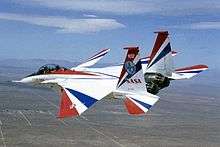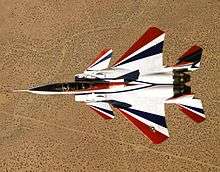McDonnell Douglas F-15 STOL/MTD
The McDonnell Douglas F-15 STOL/MTD (Short Takeoff and Landing/Maneuver Technology Demonstrator) is a modified F-15 Eagle. Developed as a technology demonstrator, the F-15 STOL/MTD carried out research for studying the effects of thrust vectoring and enhanced maneuverability. The aircraft used for the project was pre-production TF-15A (F-15B) No. 1 (USAF S/N 71-0290), the first two-seat F-15 Eagle built by McDonnell Douglas (out of 2 prototypes[2]), the sixth F-15 off the assembly line, and was the oldest F-15 flying up to its retirement. It was also used as the avionics testbed for the F-15E Strike Eagle program.[3] The plane was on loan to NASA from the United States Air Force.
| F-15 STOL/MTD / NASA NF-15B Research Aircraft | |
|---|---|
_in_flight_over_the_desert_(viewed_from_above_the_aircraft)%2C_will_start_test_flights_in_September_1994_DF-ST-94-01563.jpg) | |
| F-15 ACTIVE in 1994 | |
| Role | Technology Demonstrator and Research Aircraft |
| National origin | United States |
| Manufacturer | McDonnell Douglas |
| First flight | 7 September 1988 (STOL/MTD)[1] |
| Retired | 15 August 1991 (STOL/MTD) 30 January 2009 |
| Primary users | United States Air Force NASA |
| Number built | 1 |
| Developed from | McDonnell Douglas F-15 Eagle |
| Career | |
| Registration | NASA 837 |
| Serial | USAF S/N 71-0290 |
This same aircraft would later be used in the F-15 ACTIVE (Advanced Control Technology for Integrated Vehicles) from 1993 to 1999, and later in the Intelligent Flight Control System programs from 1999 to 2008.
While with NASA, the aircraft's tail number was 837; for the Quiet Spike program and Research Testbed it was 836, and 835 was used for the Highly Integrated Digital Electronic Control (HIDEC) program.[4]
Design and development

.jpg)
In 1975, Langley Research Center began to conduct sponsored programs studying two-dimensional thrust vectoring nozzles;[5]:44 government and industry studies of non-axisymmetric two-dimensional (2-D) nozzles in the early 1970s had identified significant payoffs for thrust-vectoring 2-D nozzle concepts.[5]:192
In 1977, Langley started a system integration study of thrust-vectoring, thrust-reversing, and 2-D nozzles on the F-15 with McDonnell Douglas. In 1984, the Flight Dynamics Laboratory, the Air Force Aeronautical Systems Division awarded a contract to McDonnell Douglas for an advanced development STOL/MTD experimental aircraft.[5]:192
The aircraft used in the STOL/MTD program[6] has flown several times since the successful STOL/MTD program completion in 1991 that used thrust vectoring and canard foreplanes to improve low-speed performance. This aircraft tested high-tech methods for operating from a short runway. This F-15 was part of an effort to improve ABO (Air Base Operability), the survival of warplanes and fighting capability at airfields under attack.
The F-15 STOL/MTD tested ways to land and take off from wet, bomb-damaged runways. The aircraft used a combination of reversible engine thrust, jet nozzles that could be deflected by 20 degrees, and canard foreplanes. Pitch vectoring/reversing nozzles and canard foreplanes were fitted to the F-15 in 1988. NASA acquired the plane in 1993 and replaced the engines with Pratt & Whitney F100-229 engines with Pitch/Yaw vectoring nozzles.[7] The canard foreplanes were derived from the F/A-18's stabilators.
Prior to August 15, 1991,[5]:194 when McDonnell Douglas ended its program after accomplishing their flight objectives, the F-15 STOL/MTD plane achieved some impressive performance results:
- Demonstrated vectored takeoffs with rotation at speeds as low as 42 mph (68 km/h)[5]:194
- A 25-percent reduction in takeoff roll[5]:193
- Landing on just 1,650 ft (500 m) of runway compared to 7,500 ft (2,300 m) for the standard F-15[5]:193
- Thrust reversal in flight to produce rapid deceleration[5]:194
- Controlled flight at angles of attack up to about 85 degrees[5]:193
Further modifications

During the 1990s the same F-15 airframe (USAF S/N 71-0290) was further modified (canards and nozzles were retained) for the ACTIVE (Advanced Control Technology for Integrated VEhicles) program in which Pitch/Yaw Balance Beam Nozzles (P/YBBN) and advanced control-logic programming were investigated. In the ACTIVE configuration it was also used for the LANCETS (lift and nozzle change effects on tail shock) program, in which computed supersonic shockwave parameters were compared to those measured in flight. The LANCETS flight tests ended in December 2008.[8] F-15 ACTIVE lasted from 1993–99.
The aircraft would later be used in the F-15 IFCS (Intelligent Flight Control System) program from 1999 to 2008. The plane was also used for the Space-Based Range Demonstration and Certification project under the Exploration Communications and Navigation Systems program (SBRDC/ECANS) from 2006 to 2007, High Stability Engine Control (HISTEC) program and High-Speed Research Acoustics in 1997.
Specifications
F-15 ACTIVE


Data from NASA.[9]
General characteristics
- Crew: 2
- Capacity: 17,000 lb (7,112 kg)
- Length: 63 ft 8 in (19.42 m) excluding flight test nose boom
- Wingspan: 42 ft 10 in (13 m)
- Height: 18 ft 6 in (5.64 m)
- Wing area: 608 sq ft (56.5 m2)
- Empty weight: 35,000 lb (15,876 kg)
- Gross weight: 47,000 lb (21,319 kg)
- Fuel capacity: 11,520 lb (5,225 kg) (approx. 1,700 gal)
- Horizontal tail span: 28.2 ft (8.60 m)
- Canard span: 25.6 ft (7.80 m)
- Powerplant: 2 × Pratt & Whitney F100-PW-229 turbofan engines, equipped with Pratt & Whitney P/YBBN 20 Degree three-dimensional thrust vectoring nozzles, 17,800 lbf (79 kN) thrust each dry, 29,000 lbf (130 kN) with afterburner
Performance
- Maximum speed: 1,522 mph (2,450 km/h, 1,323 kn)
- Maximum speed: Mach 2.0
- Service ceiling: 60,000 ft (18,288 m)
See also
Related development
- F-15 Eagle
- F-15E Strike Eagle
Aircraft of comparable role, configuration and era
Related lists
References
- "Boeing: History -- Chronology - 1988 - 1992". Boeing. c. 2010. Archived from the original on 12 May 2010. Retrieved 10 March 2019.
- "Fact Sheets: MCDONNELL DOUGLAS F-15A". National Museum of the US Air Force. Archived from the original on 3 September 2014. Retrieved 15 July 2017.
- Aircraft Description NASA 19 April 2010
- "NASA Armstrong Fact Sheet: NF-15B Research Aircraft". NASA. 28 February 2014. Retrieved 9 April 2019.
- Chambers, Joseph R (2000). "McDonnell Douglas F-15 Eagle" (PDF). Partners in Freedom: Contributions of the Langley Research Center to US Military Aircraft of the 1990. The NASA History Series. NASA. Retrieved 20 April 2010.
- "AFRL Acronyms". Air Force Research Laboratory. USAF. Archived from the original on 13 September 2010. Retrieved 19 April 2010.
- F-15 ACTIVE (graphics collection), Dryden: NASA.
- "Sonic Solutions", Aviation Week & Space Technology, p. 53, 5 January 2009.
- "NASA Armstrong Fact Sheet: NF-15B Research Aircraft". National Aeronautics and Space Administration. Retrieved 20 October 2014.
- Aircraft of the World: The Complete Guide.
External links
| Wikimedia Commons has media related to F-15S/MTD. |